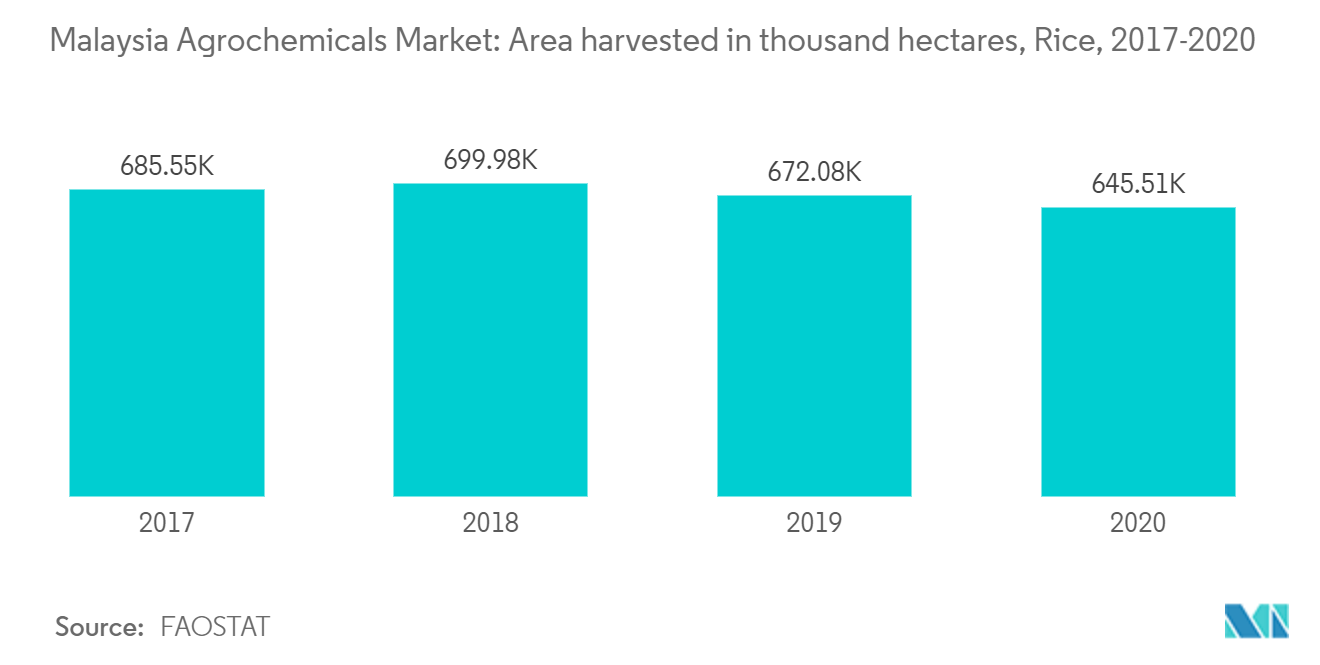Market Trends of Malaysia Agrochemicals Industry
This section covers the major market trends shaping the Malaysia Agrochemicals Market according to our research experts:
Decreasing Arable Land and Increasing Demand for Food
Malaysia is an agriculture-dependent country. Culturing valuable crops such as palm oil, rubber, and cocoa has always been important in the region. Food crops such as tropical fruits and rice are essential. For several years, Malaysia's population has been increasing rapidly. According to the World bank statistics, the people of Malaysia 32.3 million in 2020, which will increase to 32.7 million in 2021. This growing population is raising the food demand. Supplying food to this ever-increasing population has become a threat.
On the other hand, arable land is declining due to industrialization and urbanization, which decreased production. For instance, according to FAO, the area harvested under rice crops has been falling for several years, dropping ever-increasing from 672,084 ha in 2019 to 645,511 ha in 2020. This reducing arable land reduces agriculture production, negatively impacting the region's growth and leading to food security concerns.
Agrochemicals are known for improving crop productivity on a wide range of crops. So, agrochemical fertilizers have been used for a long time to increase the productivity of crops. Fair and balanced use of agrochemicals will help feed the region's growing population from the available cultivable land. This is expected to boost the demand for agrochemicals such as fertilizers and pesticides in Malaysia.
Along with this, the most potent forces driving the demand for agrochemicals include the need for crop intensification (to increase yields per acre) while pursuing increasingly sustainable practices, seeking natural alternatives to boost production with decreased pressure on the environment, or adding to integrated approaches to close the yield gap. Therefore, the decrease in the arable land and the need for increased production give rise to market growth in the forecast period.

Government support is boosting the Agrochemical sector
Agriculture is the backbone of the Malaysian economy. The increasing food demand due to the raising population is catering to the need for rising productivity. So, the government is taking several initiatives in order to satiate the demand for food. Malaysia's government has been supporting the agriculture business with a variety of measures, attempting to stabilize output and looking for ways to guarantee the sector grows in a healthy and sustainable manner. For instance, in 2022, the Department of Agriculture (DoA) introduced Fertilizer Act to promote agriculture capacities. This includes technical help from the DoA for reinforcing the fertilizer control mechanism, including counterfeit fertilizer management, to enforce the Fertilizer Act.
Along with this, the fertilizer sector currently engages in "self-regulation" in Malaysia. The Act will be utilized to address existing problems affecting Malaysia's fertilizer sector. With this, the problems will be known, and more efficient products will be developed thereby raising production. Additionally, ARISE Plus Malaysia project is implemented by the International Trade Centre provided a series of training has assisted the country in developing a full-fledged pragmatic registration framework for fertilizers that will match Malaysia with the other ASEAN countries. This increased government support is rising the sales of agrochemicals in the country. For instance, according to the Department of Statistics Malaysia the sales of pesticides and agrochemicals in 2020 is 1.88 billion Malaysian ringgit (USD 424.9 million) which increased to 2.68 billion Malaysian ringgit (USD 605.7 million). Therefore, government initiatives is increasing the sales of the agrochemicals that will contribute the market growth in the forecast period.

